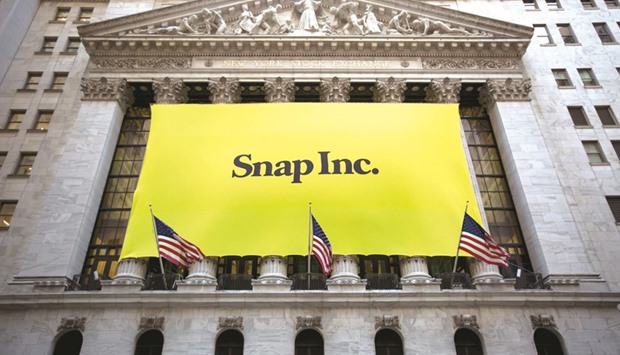If there’s one lesson Silicon Valley can learn from Snap’s trading debut, it’s that investors in initial public offerings are again willing to stomach the uncertainty of betting on hopeful, young companies.
While concerns still loom about growth and profitability at the maker of disappearing-photo app Snapchat, interest in the IPO is undeniable. After pricing the offering above the range at $17, the stock surged 44% in its debut and another 11% on its second day of trading to $27.09, valuing the company at more than $31bn. Demand for the shares outpaced the number offered by a multiple of 10.
By going public at just five years old – an early iteration of the company was formed in 2010 but it didn’t become Snapchat until two years later – Snap is bucking the trend of companies staying private for as long as possible. It only added advertising to the platform about two years ago. Ride-sharing app maker Uber Technologies, data-mining startup Palantir Technologies and Airbnb are all older than Snap and have hit higher valuations in funding rounds. They’re also all private.
Instead, Snap mirrors the likes of Amazon.com, Netflix or Alphabet’s Google, all of which decided to come of age in the public view.
“There are certainly a lot of companies that have the size and scale to go public” said Hemant Taneja, managing director at venture capital firm General Catalyst, which invested in Snap. “Snap’s offering indicates that there’s investor interest.”
Snap raised $3.4bn in the first US technology listing this year. The company is not profitable, with a net loss that outpaces its revenue: It lost $515mn in 2016 on sales of $404mn. For now, investors are having to bet on the vision of co-founders Evan Spiegel and Bobby Murphy, who must continue to engage the company’s coveted millennial audience while increasing how much money it makes from each user.
The deal comes on the back of a slow 2016 for IPOs, which saw the amount raised in technology listings plunge by 60% from the prior year. Lethargy among companies ripe for a public exit has put a damper on Silicon Valley, impacting everything from investor morale to private company funding and business strategies
Don’t blame the scarcity of IPOs on a lack of worthy candidates. There are more than 170 private technology businesses valued at least $1bn, according to data from CB Insights. There just aren’t many that feel ready to face public markets, or to test the valuations they fetched in private funding rounds. The largest companies have been some of the most vocal about wanting to stay private. Nine-year-old Uber, which boasts a valuation of $69bn and a projected $5.5bn in revenue last year, said an IPO is still some way off. That was before recent claims related to harassment and questions about the CEO’s leadership abilities.
Palantir, a $20bn data-mining startup founded back in 2004, only recently changed its tune as it approaches profitability. The Palo Alto, California-based company is considering an IPO, private equity deal or another option to allow employees to cash out their shares.
One deterrent has been a private funding market flush with cash in recent years, letting companies raise private rounds that outsize most tech IPOs. Seeing a large, relatively young – and crucially, unprofitable – peer choose instead to pursue a listing could spur others to follow suit.
“Snap going public shows that it’s a natural part of the evolution of companies, and it’s done a lot to demystify the normal progression,” said Rick Heitzmann, managing partner at FirstMark Capital. “It’s shown that you can still be innovative, cool and progressive while being a public company.”
While its fellow unicorns straggle on their routes to an IPO, Snap investors must instead look back more than a decade for examples of success under public scrutiny.
Amazon, founded in 1994, went public in 1997 with just $147.8mn in revenue and a loss of $31mn. In transitioning from an online bookseller to an all-out marketplace, losses finally began to narrow in 2001 and the company was profitable two years later. An investor who got in at the IPO would’ve seen a total return of more than 56,000%.

Snap signage is displayed in front of the New York Stock Exchange during the company’s initial public offering on March 2. Snap raised $3.4bn in the first US technology listing this year.


